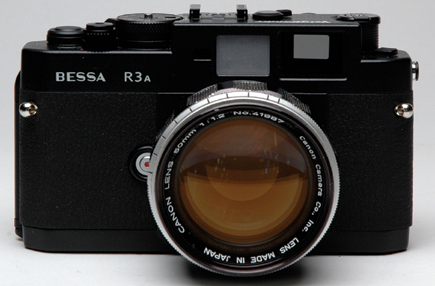Canon’s 50mm f/1.2 Rangefinder Lens; A Legend In The Super-Fast Realm
Canon's 50mm f/1.2 in Leica screwmount (39mm x 26 tpi) is something of a legend. Introduced in 1957/58, it is very fast and today it is relatively affordable. The main alternatives, after all, are either Leica Noctiluxes (the 50mm f/1.2, 1966, discontinued, or the 50mm f/1, 1967, still current) or two vanishingly rare lenses introduced in 1955, the 50mm f/1.1 Nikkor and f/1.1 Zunow, both of which are eagerly sought after by collectors. The 50mm f/0.95 Canon "Dream" (1963) was the fastest series-production 50mm lens of all time for full-frame 35mm, but rangefinder-coupled versions were not Leica screwmount: they used the external three-claw bayonet around the Leica-compatible lens mount of the last few Canon rangefinder cameras. This external bayonet was also used for mirror boxes.
 |
|
|
You can, if you are lucky, find a 50mm f/1.2 Canon for $250 or less, though
equally, you can pay $400 or more for one. But even $400 is less than a new
50mm f/1.5 Voigtländer Nokton, itself the least expensive option among
modern, fast, 50mm lenses for rangefinder cameras--and the Nokton is half
a stop slower. As the 50mm f/1.2 Canon has always had cult status, the arrival
of the Voigtländer Bessa R3A prompted me to dig mine out and try it. The
big advantage of the R3A is that the 1:1 viewfinder gives a longer effective
rangefinder base length, the full 38mm or so instead of the less than 30mm that
you get with the other R-series where the viewfinder magnification is 0.7 or
thereabouts. This improves focusing accuracy with very fast lenses.
I bought my first 50mm f/1.2 some 30 years ago, complete with a Canon body,
and sold camera and lens together after a couple of years. Then, because I regretted
getting rid of it, I bought another lens and body a few years later but sold
the body on its own for very nearly what I had paid for camera and lens together.
About 10 years ago I had the lens cleaned and rebuilt. It came back with the
glass sparkling and the focus and diaphragm operating at positively Leica smoothness.
By the standards of almost 50 years ago the 50mm f/1.2 is a bulky brute, a maximum
of 62mm (just under 21/2") in diameter and protruding some 39mm (just
over an 11/2") from the camera body. It takes 55mm filters and weighs
about 325g or almost exactly 12 oz. By modern standards, of course, it's
not very big at all. Without a hood, it barely encroaches in the 50mm frame
of the R3A.
You need a screw-to-bayonet adapter, but I already had one of those. The lens
has a vile infinity lock, which used to drive me up the wall, but I originally
disabled this by wedging a bit of toothpick into it. My repair shop in London,
Balham Optical, installed a more elegant spring which is equally removable should
I want to restore the lens to its original condition.
The focusing travel is around twice as great as most modern lenses, about 180Þ
from infinity to the closest focusing distance of 3.5 ft: there is no meter
scale on this lens, though I believe it was made in both feet and meter versions.
The movement is in the same direction as Leica lenses, clockwise to focus closer,
and the focusing ring is metal with big scallops.
































